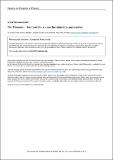Tin titanate – the hunt for a new ferroelectric perovskite
Abstract
We review all the published literature and show that there is no experimental evidence for homogeneous tin titanate SnTiO3 in bulk or thin-film form. Instead a combination of unrelated artefacts are easily misinterpreted. The X-ray Bragg data are contaminated by double scattering from the Si substrate, giving a strong line at the 2-theta angle exactly where perovskite SnTiO3 should appear. The strong dielectric divergence near 560K is irreversible and arises from oxygen site detrapping, accompanied by Warburg/Randles interfacial anomalies. The small (4μC/cm-2) apparent ferroelectric hysteresis remains in samples shown to be pure (Sn,Ti)O2 rutile/cassiterite, in which ferroelectricity is forbidden. Only very recent work reveals real bulk SnTiO3, but it possesses an ilmenite-like structure with an elaborate array of stacking faults, not suitable for ferroelectric devices. Unpublished TEM data reveal an inhomogeneous SnO layered structured thin films, related to shell-core structures. The harsh conclusion is that there is a combination of unrelated artefacts masquerading as ferroelectricity in powders and ALD films; and only a trace of a second phase in PLD film data suggests any perovskite content at all. The fact that X-ray, dielectric, and hysteresis data all lead to the wrong conclusion is instructive and reminds us of earlier work on copper calcium titanate (a well-known boundary-layer capacitor).
Citation
Gardner , J , Thakre , A , Kumar , A & Scott , J F 2019 , ' Tin titanate – the hunt for a new ferroelectric perovskite ' , Reports on Progress in Physics , vol. 82 , no. 9 , 092501 . https://doi.org/10.1088/1361-6633/ab37d4
Publication
Reports on Progress in Physics
Status
Peer reviewed
ISSN
0034-4885Type
Journal item
Description
This work was supported in St Andrews by the Engineering and Physical Sciences Research Council (EPSRC) Grant No. EP/P024637/1.Collections
Items in the St Andrews Research Repository are protected by copyright, with all rights reserved, unless otherwise indicated.

